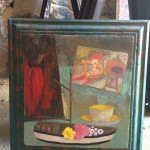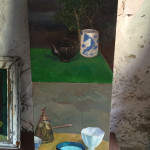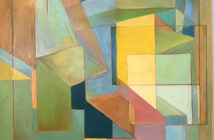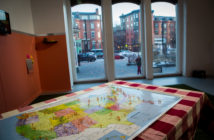My first introduction to Matt Noonan’s paintings was an eclectic arrangement of oils with dense imagery and rich colors on wood or canvas in the group exhibition Arcadia: Thoughts on the Contemporary Pastoral, curated by Steve Locke and recently on view at the Boston Center for the Arts. Noonan’s work stopped me in my tracks. The subjects included wilted flowers in vases and a female figure in a nun’s habit, her head surrounded by a fuschia halo. Each painting was a different size—some were framed, others were not. With ominous themes such as mortality, the paintings had a serious, medieval tone that was offset by sumptuous, distinctive brush strokes. I was captivated and could not look away. I set out see if I could understand this strong effect with a visit to Noonan’s studio in West Roxbury in early October.
-----------------------------------------------
Shana Dumont-Garr: Are the paintings in Arcadia part of a larger body of work? Do they represent a consistent continuation of your creative practice, or a divergence?
Matthew Noonan: I hadn’t been in the studio for a while because of kids, life and work when Steve invited me to show. I tried to use the opportunity to start fresh, to not rely on old habits of making. So I did. But then the longer I worked, I found myself returning to work I thought I had left behind. I started connecting. I started, in some cases, pulling out and repainting work I thought I had finished a decade ago. Taking my new visual vocabulary back to that place allowed me to see both bodies of work in new ways. And, for me, that is exciting.
SDG: Your paintings meld genres into surreal hybrids where still life, landscape, and geometric abstraction coexist. How did that come about?
MN: It came about through my history as a painter. When I was in school at MassArt (where I earned my BFA and my MFA), my professor Rob Moore inspired me to make color field paintings. Moore was building up color on top of color until there began to be a physicality and object-ness to the painting. Part of that appealed to me, but I focused on creating a situation or sensation when you put one color next to another, creating a back-and-forth movement of space that brings one color forward.
Aware of the plastic qualities of acrylic, I wanted to make it appear less plastic, so I avoided brushes and used a roller and a palette knife to apply the paint. I mixed wax and marble dust into the paint and then sanded the surface to eliminate distractions and focus on color. My method involved building up two different fields of colored flatness, and pursuing the quality of the colors when I changed the texture of the paint. If it was slick or flat, how did that read? I was so focused on color that my desire to tell stories in my paintings went out the window.
SDG: Then you began adding objects to your abstract compositions, and with them came the potential for additional meanings, both from the physicality of the paint and from the subject matter.
MN: When I started to incorporate images, I hadn’t used brush in a long time. Brush marks say things about personality and gesture that I wanted to avoid. I realized later that the brush can also alter and affect how we read color, and I really enjoy making marks.
I had also become frustrated with the limitations of using only a couple of colors. I couldn’t jump into becoming a landscape painter, that didn’t feel natural, but I began to play around with observational painting, setting up still lives, getting myself into a different kind of looking, but that wasn’t satisfying for long.
I kept about fifty blocks I painted with specific colors in my studio, from my time working with color fields. I spent a lot of time in the studio not always putting new paint onto surfaces, but rearranging these blocks. For me, the act of painting continues to be about the act of rearranging, despite each component’s now relatively more dense imagery.
SDG: So in a sense, your shift from color field to observational painting became a visceral transition that remains to this day.
MN: Yes, it partly had to do with habits I developed in the studio that I brought forward. These habits get me into that space of creating where everything else falls away. I adjust whenever I run out of ways to make the work interesting to me. I need to find ways to continue to make it interesting.
SDG: So you wanted to add representation before you wanted to add story?
MN: Yes. Telling stories had been anathema to me for many years, but that changed over time.
SDG: In addition to teaching and practicing visual art, you are also a writer. I think this duality is apparent in your work; I see each of your panels as phrases, or lines of poetry. Is this a conscious decision on your part?
 MN: It might not be that I’m thinking of a particular phrase when I’m making one painting, but a phrase is composed by pairing two paintings. Sometimes I make one picture, put it beside another, and ask whether the conversation is more interesting.
MN: It might not be that I’m thinking of a particular phrase when I’m making one painting, but a phrase is composed by pairing two paintings. Sometimes I make one picture, put it beside another, and ask whether the conversation is more interesting.
The impulse to repeatedly arrange the paintings comes from that history of making where I arranged a variety of color fields to explore compositional possibilities. As I arranged them I saw a vast number of potential paintings in a short amount of time. On one piece of paper, or one panel, I have relatively few options, and what I make could satisfy me a little bit, but when I work with multiples, there are more opportunities to retain my interest.
SDG: The meanings and the imagery present in your paintings reverberate more as a result of these pairings. In Arcadia, it took a while for me to realize that what I thought were four separate paintings was actually one work.
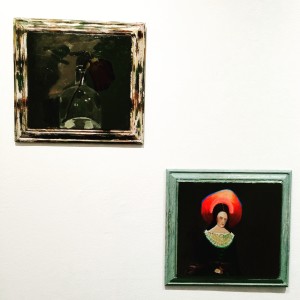 MN: Yes, that was part of my efforts to start fresh. Previously, the edges of the paintings that I joined were flush. I thought, what does it matter if I’m painting one canvas or not if it enables me to come up with surprising things I wouldn’t otherwise have found? It started to become interesting to me to create a dialogue. I placed two panels so they were abutting and placed a third panel in the corner with inches of space on either side. The rectangles of negative space became part of the work.
MN: Yes, that was part of my efforts to start fresh. Previously, the edges of the paintings that I joined were flush. I thought, what does it matter if I’m painting one canvas or not if it enables me to come up with surprising things I wouldn’t otherwise have found? It started to become interesting to me to create a dialogue. I placed two panels so they were abutting and placed a third panel in the corner with inches of space on either side. The rectangles of negative space became part of the work.
In addition to arranging the panels or canvases with each other, I also continue to work on their surfaces. I only consider a piece complete if I give it to someone as a gift, or if it is sold. Otherwise, I may for example begin something in 2011, then add to it again in 2015. I like the archaeological quality of paint from the past layered with newer marks.
SDG: How do you balance matters of color and representation now?
MN: I tell my students to define a picture versus a painting. Often they have an idea in their head: they want to make a picture of something, and that is different from making a painting of something. Paintings have an inherent physicality; it’s a two-dimensional surface with colored mud on it. Pictures don’t require that physicality. They can allow you to say, “enter me, believe in this space,” while remaining flat.
With my paintings, I start mapping the space, and there are points where viewers may ask, could that exist or coexist? I continually play with the spaces between background and foreground.
SDG: Many of your paintings have a surrealist quality. Are your subjects a combination of things you imagine and things you find, including art historical references?
MN: Yes. I think about my paintings through the lens of other painters and paintings. I like to build and borrow, borrow and build. The still life as a genre is pliable, and figuring out what to do with simply a rose in a vase is challenge enough for me. Yet I can’t help but look at what others have done. And then, when I do, I wonder how that can enter my work. What happens when I put an AstroTurf field in front of a horizon by Corot, with a toy boat in the foreground?
I begin with a real connection and a curiosity, such as: why do I find Corot’s figures enchanting, or do Max Beckmann’s skulls intrigue me because of their simplicity, or is it something else? I begin with a question about my artistic tastes, and so when I invite other painters’ vocabularies into my painting, it is to explore that question of taste: to bring that to the surface and understand it better. Sometimes, the curiosity turns out to be superficial, and at other times, it’s a source of future inspiration.
When I painted and repainted this summer for the works in Arcadia, I started out with a flower in a bottle, titled This and that (for JAN). It became a painting problem that pushed me to create that work. I changed color schemes, and applied other “what ifs.” For me, it was never about, “I’ve finally got it right! It looks like the flower in the jar! It wasn’t a quest for accuracy.
SDG: If not accuracy, what do you seek to capture in your paintings?
MN: Whatever I’m doing with the surface of the paint, if am specific enough, the painting becomes coherent and the results seem to share the same imagination, mind, and perspective. I work with a limited vocabulary of images, shapes, and ideas, but I add variety by altering their syntax. Is the visual sentence parenthetical, or short and thus more declarative? These smaller units of paintings help me say more when I group them together. Eventually I recognize what I was working toward: it locks into place, and that recognition is exciting.
- Matt Noonan, from, oil on wood.
- Matt Noonan, (and on the chopping block), oil on wood.
- Matt Noonan, between is within, oil on wood.
- Matthew Noonan, Play (For Mae), Oil on canvas, Boston Center for the Arts, Arcadia: Thoughts on the Contemporary Pastoral, July 10-September 20, 2015.
- Matt Noonan, for Steve, oil on wood, 2015.
- Matt Noonan, A few paintings, with after Corot, oil on wood, to the right.
- Matt Noonan, around and about, oil on wood.



